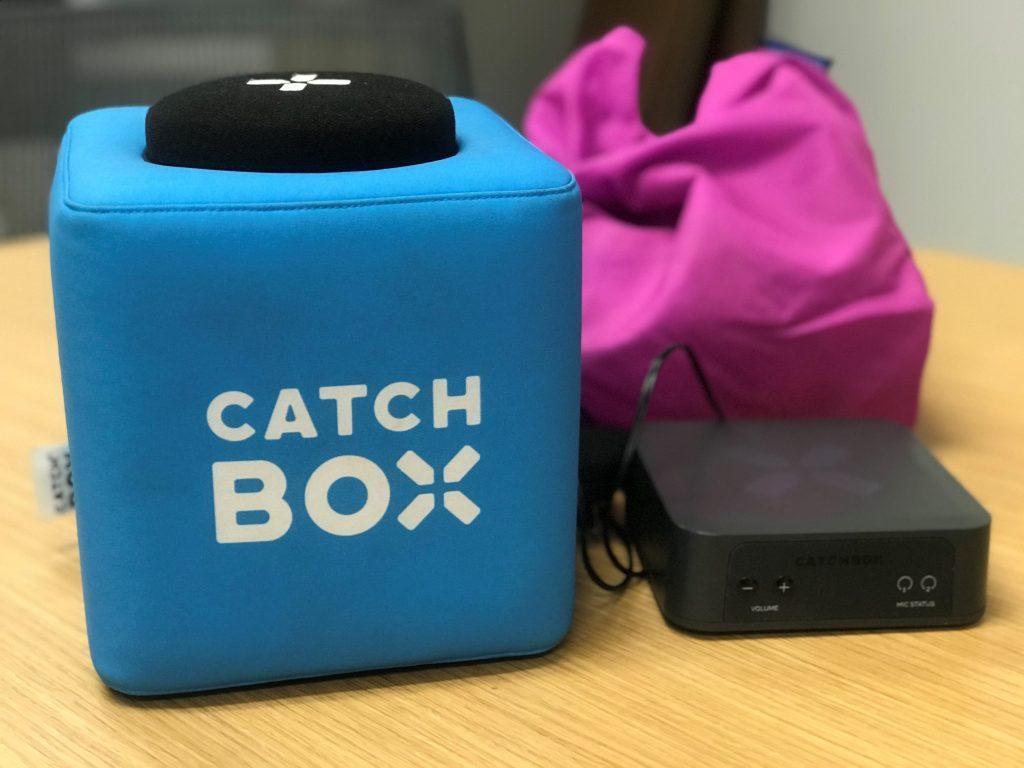
This post was written by Maria Tackett, Assistant Professor of the Practice of Statistical Science in early 2020 before changes in the classroom experience due to the COVID-19 pandemic. It is being posted now due to some renewed interest in the throwable mic. Careful consideration of university guidelines along with the comfort and safety of students and the instructor should be made before using the mic in the classroom.
Whether one uses the mic, I hope this post inspires ideas and conversation about how we can amplify more students’ voices in large classes.
In Spring 2019, I received a Jump Start Grant from Learning Innovation to purchase a throwable microphone to use in the classroom. I’ve used the throwable mic in three classes so far: STA 199: Intro to Data Science (96 students) and STA 210: Regression Analysis (75 students) in Fall 2019 and STA 210 (90 students) this semester.
In this post, I’ll share some observations about the mic after experiencing it from a student’s perspective. I’ll also share information about logistics and a few points to consider if you’re interested in using a throwable mic in your classroom.
A “student’s” perspective
In February 2020, I got a glimpse of the student experience in Regression Analysis. My class participated in the Duke Data Expedition, so two Ph.D. students did a guest lecture, and I was able to assume the role of a student for the day. I decided to sit towards the back of the classroom since I’m often in front of the room during class. They agreed to use the throwable mic, so I got a better understanding of how the mic impacted the student experience for those sitting furthest away from the instructor.
Because students’ voices were being projected through the classroom’s audio system, the mic changed the dynamic of the class discussions Students don’t get many opportunities to clearly hear one another speak to the entire class, especially in a relatively large class like mine with 90 students. To ensure students hear what their classmates have to say, instructors often repeat a student’s question or comment. While this is a commonly used approach to ensure students hear every part of the classroom discussion, there were some additional benefits from having students use the throwable mic.
- Hearing a variety of voices made the class discussion feel more like a true dialogue, rather than a monologue by the instructor. Hearing the students’ voices at the same volume and clarity as the instructor’s helped reinforce the idea that students’ thoughts and questions should be given the same level of attention as the instructor’s.
- The mic gives students an opportunity to hear one another’s “unpolished” questions and comments. During an in-class activity, a student explained to the class how she arrived at the correct answer. As she was explaining her thought process, we heard her clarifying her thoughts as she spoke. Though she originally had the correct answer, it wasn’t until she explained it to the class that she really started to put together the concepts. I believe it was helpful for students to listen to her think out loud, because it was an example of the learning process as students go from the the first introduction of a concept to a deeper understanding.
When I repeat a student’s comments, I have a tendency to present a polished version where I streamline the thought process, inserted the correct technical terms, etc. This could give students the false impression that their peers immediately have a perfect understanding of the material and may not be aware that the instructor is clarifying the statement as they repeat it. - The act of throwing the mic helps maintain some moments of energy in the class. It’s hard not to see the giant foam box moving around the classroom. Even when there was not an activity happening and students just asked questions, watching the giant foam box move around the room provided an unexpected element that kept my attention.
Logistics

It takes a few weeks to have a throwable mic set up in a classroom, so it is best to start the process the semester before you intend to use the mic. Below is a brief outline of the process:
- Purchase the mic. I use the Catchbox Plus with wireless charger. There are numerous throwable mic companies and models, so it is good to consult with Trinity Technology Services Classroom Support before purchasing a mic.
- Have the mic installed in the classroom. I submitted a request to connect the mic to the classroom audio system through the Specialized Classroom Support Request form. Once the mic was installed, I met with a member from the Classroom Support Team to learn how to operate the mic through the classroom’s audio/visual system.
- Use the mic! There is not currently a way to securely store the mic in the classroom, so I have a bag designated for the mic and receiver that I carry to class each day. Once I get to class, I plug in the receiver, turn on the mic, and I’m ready to start using it.
Final thoughts and observations
I’ll conclude with a few observations and things I’ve learned since using about using the mic:
- It will take time for students to get used to the mic. The throwable mic is new to the overwhelming majority of students, so it will take time for them to get in the habit of using it. Not only do they have to adapt to having their voice projected around the classroom, but they have to get used to throwing (or passing) a foam microphone around the room. Beginning from the first day of class, I had students use the mic when they ask questions or participate in discussion. After a few weeks, most students are in the habit of using the mic. I’ve also noticed that students are more receptive to using the mic when I was more enthusiastic about throwing, passing, and catching the mic.
- The pace of the class has slowed down some. I’ve noticed that the pace of my classes has been slower since using the mic. I think this is in part because it takes time to pass the mic around. I think this may also be because more students are asking questions and participating in discussions. Though I’ve had to restructure some of my lectures, it has made me be more thoughtful about the amount of content I can realistically cover in a single lecture.
- The mic doesn’t solve everything! Though I have observed more students participating and asking questions since using the mic, I still have to be mindful about not only engaging the handful of students who raise their hand quickly and frequently. I continue to develop in my knowledge and skills to implement other active learning and inclusive teaching techniques for engaging students in a large class.

